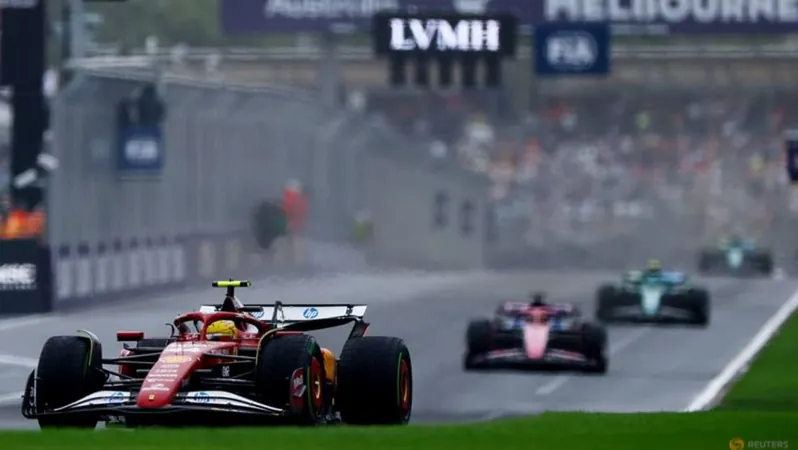
Proba-3's Historic Leap: The First Autonomous Formation Flight in Space
2025-03-27
Author: Wei Ling
Proba-3's Historic Leap: The First Autonomous Formation Flight in Space
In a groundbreaking achievement for space exploration, the European Space Agency's Proba-3 mission recently marked a significant milestone with its inaugural autonomous formation flight between two spacecraft. This remarkable event, which took place earlier this week, is a critical step towards the mission's ultimate objective: having two spacecraft operate in flawless tandem as if they were a single entity.
Both Proba-3 satellites—the Coronagraph and the Occulter—successfully aligned with the Sun, maintaining their relative position for an impressive duration of several hours without any command input from ground operations. This feat of technological prowess was achieved at ESA's European Space Security and Education Centre (ESEC) in Redu, Belgium, where a dedicated team of engineers monitored complex data displays, ensuring everything proceeded smoothly during the test.
Proba-3 is heralded as the world's first precision formation-flying mission. When fully operational, the two spacecraft will fly just 150 meters apart, simulating a gigantic single spacecraft capable of studying the Sun's faint corona—a mysterious and barely understood outer atmosphere—from a uniquely advantageous position. The Occulter’s 1.4-meter disc will block the Sun's intense glare, allowing the Coronagraph to examine the corona’s intricate structures in unprecedented detail.
Unlike earlier missions that utilized formation-flying technology, Proba-3 will set a new standard by maintaining precise positions with an accuracy of mere millimeters. This autonomy allows for complex orbital maneuvers to be performed without direct control from Earth, greatly increasing flexibility and effectiveness in scientific observations.
During the initial phase of these operations, the teams at ESEC executed a series of ground-commanded maneuvers, bringing the satellites from a distance of about 600 meters to a mere 144 meters apart. Following this adjustment, the satellites activated their onboard autonomous systems to ensure they stayed in perfect alignment.
Proba-3 mission manager Damien Galano explained the technological intricacies involved: “We utilized GPS data to ascertain the satellites' exact locations and commanded thrusters to minimize their distance effectively. After achieving the close formation, the spacecraft transitioned to onboard autonomy, utilizing a Visual-Based System consisting of cameras and LED markers for precise tracking.
This cutting-edge technology enables the Occulter to send positioning commands to the Coronagraph, automatically correcting any drift detected by their systems. This level of autonomy is a game-changer, allowing for continuous scientific observation without interruptions from ground control.
The significance of this mission extends beyond its immediate goals; the technologies demonstrated are crucial for future endeavors in space exploration. ESA's General Support Technology Programme (GSTP) has facilitated the development of many of the tools employed in Proba-3, underscoring the importance of collaboration across various scientific disciplines to advance space research.
Setting new benchmarks in autonomous flight, Proba-3 will undoubtedly pave the way for a new era of space missions. It not only showcases how far space technology has come in the last decade but also highlights humanity's relentless pursuit of knowledge about the universe. As we look to the future, the Proba-3 mission stands as a testament to innovation and cooperation, opening doors for more ambitious scientific quests in the cosmos.
As experts gather to assess the wealth of data collected during this autonomous trial, there is palpable excitement about fine-tuning the systems for high-precision operations in the weeks ahead. The pursuit of knowledge simply does not get more thrilling than this!



 Brasil (PT)
Brasil (PT)
 Canada (EN)
Canada (EN)
 Chile (ES)
Chile (ES)
 Česko (CS)
Česko (CS)
 대한민국 (KO)
대한민국 (KO)
 España (ES)
España (ES)
 France (FR)
France (FR)
 Hong Kong (EN)
Hong Kong (EN)
 Italia (IT)
Italia (IT)
 日本 (JA)
日本 (JA)
 Magyarország (HU)
Magyarország (HU)
 Norge (NO)
Norge (NO)
 Polska (PL)
Polska (PL)
 Schweiz (DE)
Schweiz (DE)
 Singapore (EN)
Singapore (EN)
 Sverige (SV)
Sverige (SV)
 Suomi (FI)
Suomi (FI)
 Türkiye (TR)
Türkiye (TR)
 الإمارات العربية المتحدة (AR)
الإمارات العربية المتحدة (AR)